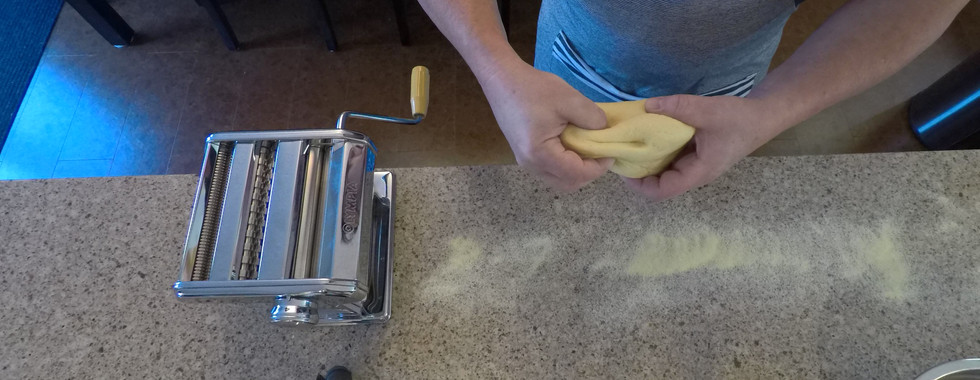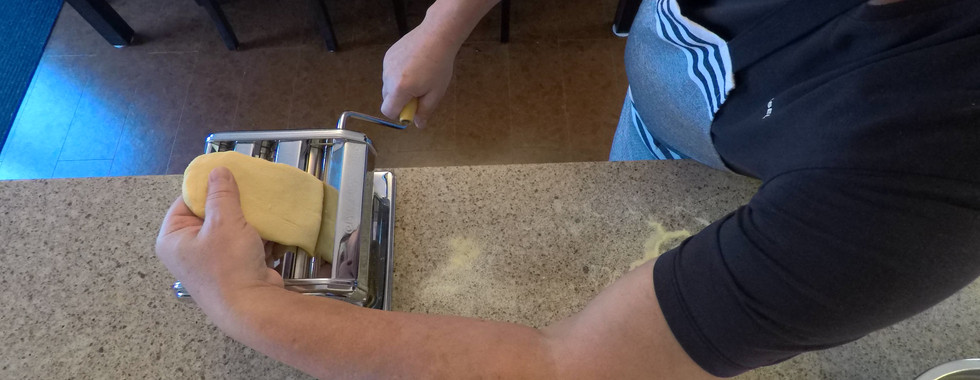
About the Process
The pasta machine is relatively simple to use. Follow these instructions and you will can master the process and make your very own fantastic pasta.

Ingredients
N/A - Instructions Only
Instructions
Pasta Machine Overview
There are manual pasta machines, others that attach to a standup mixer and standalone electric models.
These instructions are for manual models and those that attach to a standup mixer. Certainly, the type that attach to a standup mixer make the job much quicker and easier than the manual models.
With manual models, the pasta roller and pasta cutters are typically all included in a single unit. However, with models that attach to a standup mixer, the pasta roller and cutters are typically separate attachments.


The manual pasta machine consists of a few basic parts.
The flat rollers, to roll the dough into a sheet.
The cutting rollers, to cut sheets into spaghetti or fettuccini. Some pasta machines have more cutting blades than others.
The setting wheel, to control the thickness of the sheet. The larger the number, the narrower the gap or the thinner the sheet.
A mounting clamp to secure the pasta machine to the counter.
A crank handle to turn the rollers.
1 - Sheet Rollers

2 - Cutting Rollers

3 - Thickness Setting Wheel

4 - Mounting Clamp

5 – Crank Handle


There is a separate crank handle slot for each roller.
Using the Manual Pasta Machine
Sprinkle a bit of semolina or all-purpose flour onto the counter in front of the pasta machine where your dough will be rolling out.
Using about 100 grams of dough, form a flattened loaf that is thin enough to fit through the thickest setting on the pasta machine.
Run the pasta through the pasta machine on “1”, or whatever the wisest setting is.
On some pasta machines, the lowest number is the widest setting but on other machines it is the thinnest setting. For example, on my standup mixer attachment, "1" is the thinnest setting but on my manual pasta machine "1" is the thickest or widest setting.
You will have to run it through about 5 times on the widest setting. For the first 2 runs, fold the dough back into a nice rectangle before running it through again. The object is to form an even sheet of pasta.
You will have to lightly flour both sides of you dough each time you put it through the machine. Use the same flour as the flour used to make the pasta (all purpose / dirham semolina)
For the last 2 runs, do not fold the dough back into a rectangle as the dough should be properly shaped at this point.
First Roll
Forming a Rectangle
Second Roll
Forming a Second Rectangle
Third Roll
At this point, do not form a rectangle but pass the dough through the rollers 2 more times.
Increment/decrement the number in the setting wheel to 2 (or 1 level thinner) and then pass the sheet through 2 times.
Pass the strip through twice on each setting until you reach the desired thickness.
The thickness required will vary with how the pasta will be used. For example, a different thickness will be required for, dumplings, ravioli, spaghetti, and so on. The required thickness will be indicated in my recipes where fresh pasta is called for.
You can make wide sheets or narrow sheets, depending on what you're making.

Cutting The Pasta
If you are making spaghetti or fettuccini (the common cutting options on a pasta machine) run the pasta through the appropriate cutter and hang the pasta on a drying rack. Otherwise, follow the instructions for the type of pasta you are making (example: ravioli).

Using the Standup Mixer Attachments To Make Pasta
Basically, everything is the same except the cranking.









































































































